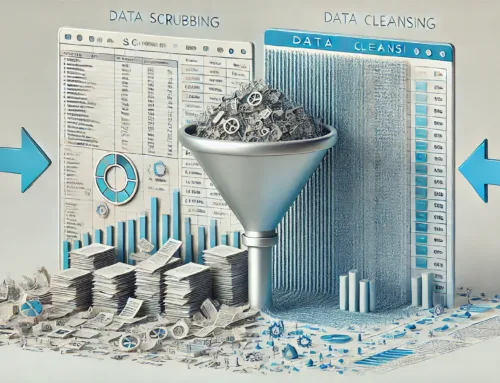When it comes to optimizing your data quality, employing effective data scrubbing techniques is paramount. From utilizing advanced data profiling tools to implementing automated cleansing processes, these strategies can significantly enhance the accuracy and reliability of your datasets. By diving into the intricacies of field-level validation, anomaly detection algorithms, and data normalization practices, you pave the way for improved decision-making and streamlined operations. Stay tuned to uncover how these seven techniques can revolutionize your data management practices and elevate your analytical capabilities.
Data Cleansing
When it comes to data cleansing, your primary goal is to ensure that your datasets are free from errors, inconsistencies, and inaccuracies. Data cleansing involves the process of detecting and correcting corrupt or inaccurate records within a dataset to improve its overall quality. One essential aspect of data cleansing is data profiling, which involves analyzing the data to gain insights into its quality and structure. Data profiling tools play a crucial role in this step by automatically examining the data, identifying anomalies, and providing a comprehensive overview of the dataset.
In addition to data profiling, data enrichment techniques are also commonly used during the data cleansing process. Data enrichment involves enhancing existing datasets by adding relevant information from external sources. By enriching your data, you can fill in missing gaps, correct errors, and standardize formats, ultimately improving the overall quality and usefulness of your datasets. Implementing effective data cleansing techniques such as data profiling and data enrichment can significantly enhance the accuracy and reliability of your datasets.
Data Quality
To ensure the reliability and usefulness of your datasets, maintaining high data quality is essential. Data quality involves ensuring that your data is accurate, complete, consistent, and relevant for your intended purposes. Data profiling is a key aspect of data quality, involving the analysis and assessment of data to understand its structure, content, and quality. By conducting data profiling, you can identify any anomalies or issues within your datasets, enabling you to take corrective actions such as data cleansing or enrichment.
Data governance and data stewardship are crucial components of maintaining data quality. Data governance establishes the policies, processes, and standards for managing and ensuring data quality throughout its lifecycle. On the other hand, data stewardship involves assigning responsibilities to individuals or teams to oversee the implementation of data governance practices and ensure that data quality standards are upheld.
Data Accuracy
When ensuring data accuracy, utilizing error detection methods becomes crucial in identifying inconsistencies and discrepancies within your datasets. Automated cleansing tools offer a proactive approach to rectifying inaccuracies swiftly and efficiently. By incorporating these techniques, you can streamline the data scrubbing process and enhance the overall quality of your data.
Error Detection Methods
Implementing effective error detection methods is crucial when ensuring data accuracy in any system. To achieve this, consider the following techniques:
- Data Profiling: Utilize data profiling tools to analyze the structure, content, and quality of your data. By understanding the characteristics of your data, you can identify potential errors or inconsistencies that may impact its accuracy.
- Anomaly Detection: Implement anomaly detection algorithms to identify outliers or irregularities within your dataset. These anomalies could indicate errors in the data that need to be investigated and corrected to maintain accuracy.
- Cross-Field Validation: Implement cross-field validation checks to ensure the consistency and integrity of data across different fields. By comparing data values across multiple fields, you can detect discrepancies or errors that may compromise the accuracy of the information.
Automated Cleansing Tools
Utilizing automated cleansing tools is essential for maintaining data accuracy in any system. These tools streamline the process of identifying and rectifying errors within large datasets, ensuring that your data remains reliable and up-to-date. Automated cleansing tools help to detect inconsistencies, duplicates, and inaccuracies efficiently, saving time and resources compared to manual review methods.
One key feature of automated cleansing tools is the ability to perform data enrichment. This process involves enhancing existing data by adding missing information, standardizing formats, and validating entries against external sources. By enriching your data automatically, you can improve its quality and relevance for analysis, decision-making, and reporting purposes.
In contrast to manual review, automated cleansing tools offer a more systematic and thorough approach to identifying and resolving data issues. They can handle large volumes of data quickly and accurately, ensuring that your database remains clean and reliable. By incorporating automated cleansing tools into your data management processes, you can enhance data accuracy and efficiency significantly.
Data Validation
How can you ensure the accuracy and reliability of your data? Data validation is crucial for maintaining data integrity and consistency. By implementing effective data validation techniques, you can enhance the quality of your data and prevent errors that may impact decision-making processes.
- Perform Field-Level Validation: Check each data field for accuracy and consistency. This includes verifying data types, formats, and ranges to ensure they meet predefined criteria.
- Cross-Field Validation: Validate relationships between different data fields. For example, ensuring that a customer’s age matches their date of birth and that the shipping address corresponds to the correct postal code.
- Implement Data Integrity Constraints: Enforce rules and constraints within your database to maintain data integrity. This includes setting primary key constraints, unique constraints, and foreign key constraints to prevent inconsistencies and inaccuracies.
Data Deduplication
Data deduplication, a process essential for data management, involves identifying and eliminating duplicate entries or records within a dataset. Duplicate detection is a crucial aspect of this process, as it allows for the efficient consolidation of data. By identifying and removing duplicate entries, data deduplication helps in streamlining databases, improving data quality, and reducing storage costs.
When implementing data deduplication, advanced algorithms are used to compare records and identify similarities. These algorithms help in pinpointing redundant data points, which can then be consolidated or removed. Through this consolidation process, data redundancy is minimized, leading to cleaner and more efficient datasets.
Data deduplication plays a vital role in enhancing the overall data quality and integrity of a database. By eliminating duplicate entries, organizations can ensure that their data is accurate, up-to-date, and reliable. Additionally, this process helps in optimizing storage space and improving data retrieval times. In conclusion, data deduplication is a fundamental technique in data scrubbing that significantly contributes to effective data management practices.
Data Normalization
When it comes to data normalization, your focus should be on standardizing data formats, eliminating duplicate entries, and rectifying missing values. By standardizing data formats, you ensure consistency across your datasets, making it easier to analyze and process information. Removing duplicate entries and addressing missing values not only enhances the accuracy of your data but also streamlines your data scrubbing process.
Standardize Data Formats
To ensure the effectiveness of data scrubbing techniques, one crucial step is standardizing data formats, also known as data normalization. Standardizing data formats involves transforming data into a consistent format, making it easier to compare, analyze, and process the information effectively. This process plays a vital role in enhancing the overall quality of the data and optimizing data management practices.
- Consistency: Ensuring that all data fields follow the same format and structure across the dataset.
- Normalization: Converting data into a standard format, such as date formats or numerical representations, to facilitate accurate analysis.
- Alignment: Aligning data formats with industry standards and best practices to improve interoperability and data integration processes.
Remove Duplicate Entries
Removing duplicate entries is a critical aspect of data normalization. When dealing with large datasets, duplicate records can lead to inaccuracies and skewed analysis results. To ensure data integrity, it is essential to employ record consolidation techniques. This involves identifying duplicate entries based on specific criteria such as unique identifiers or key fields. Once duplicates are identified, data reconciliation processes come into play. Data reconciliation helps in merging duplicate records, retaining relevant information, and eliminating redundant data. By removing duplicate entries through record consolidation and data reconciliation, you can streamline your dataset and prevent errors in analysis. This process enhances the overall quality of your data, making it more reliable and actionable for decision-making purposes. Remember, effective data scrubbing involves not only removing duplicates but also ensuring that the remaining data is accurate and consistent.
Address Missing Values
How do you handle missing values when normalizing your data? When addressing missing values in your dataset during the data normalization process, it is crucial to employ effective techniques to ensure the integrity and accuracy of your analysis. Here are three key strategies to consider:
- Impute missing values: Utilize methods such as mean, median, or mode imputation to fill in missing data points based on the characteristics of the dataset. This helps maintain the overall structure of the data while accounting for the missing values.
- Handle outliers: Identify and address outliers in your dataset before imputing missing values to prevent skewed results. Outliers can significantly impact the imputation process and distort the normalization of the data, so it is essential to handle them appropriately.
- Consider advanced imputation techniques: Explore more sophisticated imputation methods like K-nearest neighbors (KNN) or multiple imputation to impute missing values based on the relationships between variables, providing more accurate normalization results.
Data Transformation
Through data transformation, you can convert raw data into a format that is more suitable for analysis and processing. This process involves various techniques such as data enrichment and data enhancement, which aim to improve the quality and value of the data. Data masking and data obfuscation are also essential aspects of data transformation, especially when dealing with sensitive information that needs to be protected.
Data enrichment involves adding additional relevant data to the existing dataset, enhancing its completeness and accuracy. On the other hand, data enhancement focuses on refining the quality of the data by removing inconsistencies or errors. These steps are crucial in preparing the data for further analysis and decision-making processes.
In contrast, data masking and obfuscation play a vital role in safeguarding sensitive data during transformation. By disguising or replacing sensitive information with fictitious but realistic data, organizations can protect privacy and comply with data security regulations. Overall, data transformation is a fundamental step in the data scrubbing process, ensuring that the data is optimized for accurate analysis and utilization.
Frequently Asked Questions
How Does Data Scrubbing Impact Cybersecurity Measures?
Data scrubbing is crucial for data privacy and information security. By cleaning and organizing data, it reduces vulnerabilities and enhances cybersecurity measures. Make sure to implement effective data scrubbing techniques to safeguard your sensitive information.
What Are the Common Challenges Faced During Data Deduplication?
When deduplicating data, common challenges arise like ensuring data accuracy and efficient duplicate detection. It requires thorough analysis to prevent data discrepancies and maintain quality. Implementing robust algorithms and validation processes can help overcome these hurdles effectively.
Can Data Normalization Improve Data Visualization Outcomes?
Data normalization can greatly enhance data quality and accuracy, leading to improved data visualization outcomes. By standardizing data formats and structures, you ensure consistency and reliability in your visual representations, making insights more reliable.
How Can Data Validation Techniques Prevent Fraudulent Activities?
Just like a skilled detective unravels mysteries, data validation techniques act as your vigilant guard, ensuring data accuracy and preventing fraudulent activities. By meticulously verifying information, errors are caught, and malicious intent thwarted.
What Role Does Artificial Intelligence Play in Data Transformation Processes?
In data transformation processes, AI integration is pivotal. Machine learning aids in data cleansing, enhancing data quality. AI’s ability to automate tasks, identify patterns, and adapt algorithms to changing data sets significantly improves overall data transformation efficiency.




